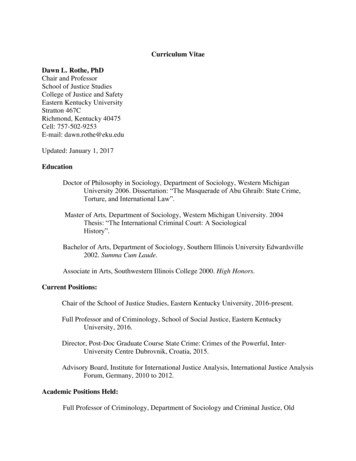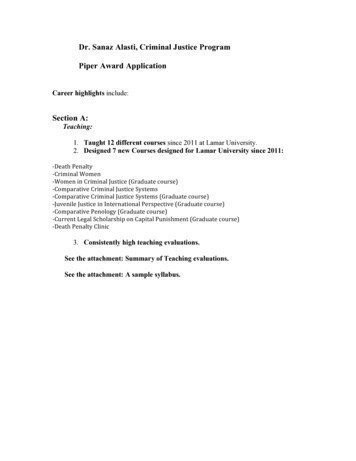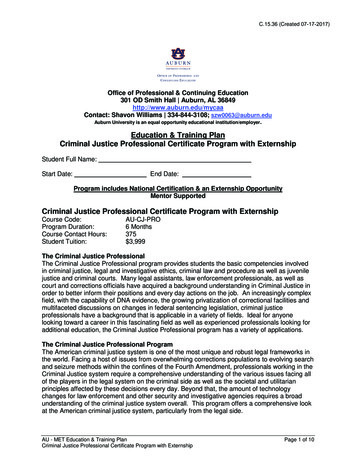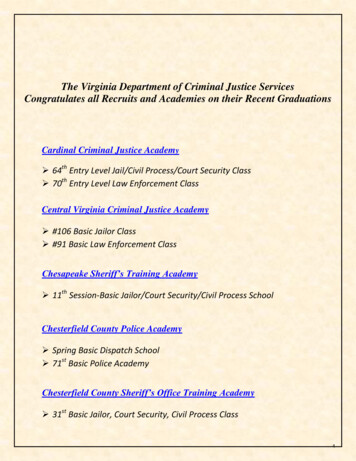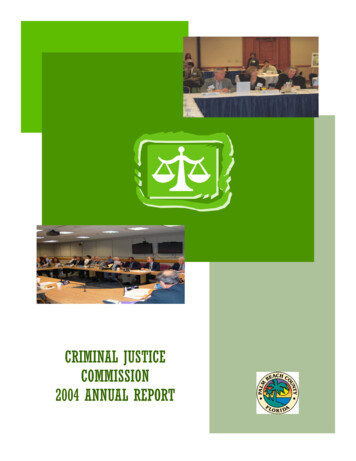
Transcription
CJBAT Test Preparation forLaw Enforcement Officer andCorrections Officer CandidatesProvided by I/O Solutions, Inc.2010Florida Criminal JusticeBasic Abilities Tests
What is the CJBAT? The Criminal Justice Basic Abilities Test, or CJBAT, is atest program that determines whether or not candidatespossess the minimum competencies required forenrollment in Florida Commission-certified trainingcenters and for employment within the state of Florida assworn law enforcement or correctional officers.The CJBAT can be administered in a traditional paperand-pencil format or via a computer-based testadministration platform.
Content of the Tutorial Test-taking strategies.The types of abilities that will be assessed by theCJBAT, followed by sample questions.Tips to improve your score.
Important Information Both the law enforcement (LEO) and correctional officer(CO) tests are 120 items in length.You have 2 ½ hours to complete the exam.Be sure to pace yourself so that you can complete theentire exam.
Exam planAbility areaNumber of itemsfor LEO testNumber of itemsfor CO testWrittencomprehension1515Written expression1515Problem sensitivity1515Inductive reasoning1515Deductive reasoning1515Information ordering1515Spatial orientation1515Memorization1515
Nine Basic Test Rules1.2.3.4.5.6.7.8.9.Promptness is mandatory for admittance to the test on the date and timescheduled.Photo identification is mandatory for admittance to the test.Due to the security measures that will be in place, only authorizedcandidates will be admitted to the test site.Calculators, spelling aids, photographic devices or other electronicdevices will NOT be allowed at the test site.Beepers, cellular phones and other communication devices will not bepermitted during testing. If you choose to use an unauthorizedcommunication device in violation of testing guidelines, your testwill be terminated and considered invalid.Handbags, backpacks or other personal items will be placed on the floorunder your work area (table/desk). You may not open your handbag,backpack or any other personal belongings during the testing process.You will undergo the same standardized process as all other candidateswith respect to the testing process (e.g., notification, instructions, etc.).All questions or concerns that arise during the testing process should bedirected to the designated proctor or test-administration staff person(s).It is strictly prohibited for you to leave the test site with any test materials.All test materials supplied must be returned before you exit the test site.
General Strategies for Taking the CJBAT Listen Carefully. The exam administrator will provide you with complete instructions for taking the exam. Besure that you pay close attention to all test instructions. It is extremely important that youcompletely understand the directions before the exam begins.Ask questions. If there are instructions that you do not understand or if something is not clear, please feelfree to ask the exam administrator any questions that you may have before the exam begins.Note start and end times. Just before the test administrator begins the test, make a note of the time the test will actuallybegin and the time that the test will end.Keep track of time. It is important that you keep track of your time so that you are able to pace yourselfthroughout the exam. You do not want to run out of time and leave questions unanswered.Your score will be based on the total number of correct answers.Remain calm. It is important that you remain calm throughout this exam so that you are able to work mosteffectively. You can’t allow yourself to become nervous or confused by a few difficult orchallenging questions.Read each question and answer option carefully. Be sure that you understand what the question requires of you. Keep in mind that incorrectanswers are sometimes designed to divert or distract you from the correct response. Carefullyread each answer option.Read for meaning. Don’t get stuck on words or sentences you do not understand. You may be able to get themain idea from a sentence or paragraph without understanding the individual words or theindividual sentences.
General Strategies, continued. Watch out for words that are sometimes designed to mislead! Watch out for answer options that contain the words “only,” “always,” “never” and“all.” Make sure that you carefully read any passages accompanying the questionto determine whether the answer option is accurate or an exaggeration. This doesnot mean that any answer option containing the words listed above isautomatically incorrect. Again, you must carefully read to determine the validity ofan answer option.Try to answer the question correctly before you look at the answers given. If you know the answer, compare it to the available choices and pick the choiceclosest in meaning to the answer you have in mind.Answer easy questions first. It is important that you answer the easy questions first on this exam. By doing so,you will afford yourself more time to spend on the difficult questions if necessary.Seek out questions you can answer. If there are particular kinds of questions thatyou feel most comfortable with, answer those questions first.Don’t waste time on questions you can’t do. If you believe that you are not able to answer a question, then skip it. It is betterto skip a difficult question than to spend a lot of time on it and not be able tocomplete other exam questions.
General Strategies, continued. Use a process of elimination. If a situation presents itself where you are unable to answer a question, use aprocess of elimination to narrow your options. First, eliminate any answers thatare clearly wrong. Then determine how you feel about the remaining choices.Guessing. Remember that you should pace yourself so that you can read and carefullyconsider each question. However, keep in mind that only correct answers will becounted as part of your score; therefore, a wild guess would be better than aspace left blank on your answer sheet. You will not be further penalized for awrong answer, and you may just guess the right answer. If you see that you arerunning out of time, mark the remaining spaces with the same answer.Statistically, some of these answers will be right. Of course, it is always better tomake an educated guess rather than a wild guess. Using the process ofelimination, make a guess from the choices that remain. The odds of guessing aright answer will increase if you can choose between two or three options ratherthan four or five.Extra time. If you finish the exam before the time period is over, review your answers andmake any changes that are necessary. Also make sure that you have markedyour answers on the answer sheet correctly.
Abilities to be Assessed The CJBAT for law enforcement officers and correctionalofficers will assess your ability in three main areas: Language abilityVisualization abilityReasoning ability
First Area: Language Ability The language ability will be measured with the followingtypes of questions: Written comprehension: ability to read and understand writtenwords and sentences. Law enforcement and correctional officersuse this ability when reading legal bulletins, Florida statutes,ordinances, policies and procedures.Written expression: ability to write words and sentences thatother people will understand. Law enforcement and correctionalofficers use this ability to write the many reports, memos,affidavits and narratives that they are required to complete.The next few slides will take you through sample questions for thewritten comprehension and expression abilities.
Written Comprehension: Sample Question 1Please use the information in the following passage to answer written comprehensionsample question 1.Ms. Amelia Winters called the Fort Lauderdale Police Department at approximately 8:45 p.m.Wednesday evening to report a burglary in her apartment. Ms. Winters, who lives with threeroommates, reported that she was alone in the apartment at the time of the incident. She was readingin the living room when she heard a noise in the bedroom. She did not immediately investigate thesituation because she assumed that she must not have noticed one of her roommates returning homeearly. However, when her greetings went unanswered, she walked into the bedroom to see who was inthe apartment. She walked through her bedroom, looked into an adjoining bathroom and discovered ayoung Caucasian male, approximately six feet tall, age 14-16, standing in her shower, attempting tokeep out of sight. He had short brown hair and was wearing sunglasses. He was wearing a plain red tshirt, blue jeans and black Nike sneakers. Ms. Winters ordered the young man to leave, and he raninto the bedroom and climbed out of an open bedroom window. After he left, Ms. Winters suddenlygrew fearful and went next door to a neighbor’s apartment to seek help and call the police. When shereturned, she noticed that her purse had been stolen. She did not know exactly when the purse hadbeen stolen although she remembered that she had last seen it lying on her bed.1. Where was the suspected burglar hiding?a)In the living room.b)In the bedroom.c)Inside an adjoining bathroom in the shower.Just beneath an open bedroom window.d)
Answer to Sample Question 1The correct answer to written comprehension sample question 1 is(c), “Inside an adjoining bathroom in the shower,” because that isthe location where Ms. Winters found the young man hiding.Answers (a), (b) and (d) are incorrect. Ms. Winters was alone in theliving room until she went to investigate the noise in the bedroom;therefore, the burglar was not hiding there. Although the burglarprobably stole the purse from the bedroom and although he walkedthrough the bedroom to escape, he was not hiding in that room. Heused the open bedroom window to escape and not to conceal hispresence.
Written Comprehension: Sample Question 2Please use the information in the following passage to answer writtencomprehension sample question 2.Correctional Officers Craig Spencer and Sean Pryor work at the Lake Correctional Institution. At 4:45p.m. on Thursday afternoon, Correctional Officers Spencer and Pryor were monitoring inmates in therecreational yard when they noticed Inmate Louis Dodgson arguing with Inmate Charles Boulton. Asthey approached the fighting inmates, the argument escalated, and Inmate Dodgson produced ahomemade weapon, made from a disposable razor and a ballpoint pen, which he used to cut InmateBoulton’s arms and face. Correctional Officers Spencer and Pryor attempted to subdue InmateDodgson and confiscate the weapon. Inmate Dodgson became disorderly and struggled withCorrectional Officers Spencer and Pryor. Inmate Dodgson dropped the weapon, which was quicklyconfiscated by Correctional Officer Pryor. Inmate Dodgson then punched Correctional Officer Spencerin the right eye and on the left side of his jaw. Correctional Officer Spencer was assisted byCorrectional Officers Pryor, Davis, Leonard and Atkins. Inmate Dodgson was subdued and wastransferred to another institution pending evaluation of his status. Inmate Boulton and CorrectionalOfficer Spencer were both treated by prison medical staff.2. Who sustained cuts on his arms and face during the attack?a)b)c)d)Inmate DodgsonInmate BoultonCorrectional Officer SpencerCorrectional Officer Pryor
Answer to Sample Question 2The correct answer to written comprehension sample question 2 is(b), “Inmate Boulton,” because Inmate Boulton was the one whowas cut on his arms and face during his argument with InmateDodgson. Answers (a), (c) and (d) are all incorrect answers.Inmate Dodgson was the person who was attacking the inmate andofficer; he received no injuries that were reported in the previousparagraph. Correctional Officer Spencer was injured by InmateDodgson, but he was hit in the right eye and on the left side of hisjaw. Correctional Officer Pryor was not injured while he helped tosubdue Inmate Dodgson.
Tips for Improving your Written Comprehension Before the test day, read entire newspaper articles for practice. Underlineimportant details and ideas and notice different points of view and types ofsupporting evidence. After you have finished the article, try to summarizethe main point of the article and the different arguments that have beenpresented. Look over the words and sentences you have underlined. Werethey the most important words and ideas? As you continue to practice thisexercise, you will become a more efficient reader, and you will read withgreater comprehension.One strategy you may find helpful is to read the questions before you readthe selection. The questions will tell you what important details you need tonotice as you read the passage.Make sure that you read each question very carefully. Many candidatesmake mistakes on written comprehension questions because theymisunderstand the questions.Read all of the answer choices carefully. Try to eliminate incorrect answersuntil you are left with only one possible answer. If you have more than onepossible answer, reread the passage.
Written Expression: Sample QuestionsFor written expression sample question 1, determine which word in the sentence isspelled incorrectly. There will be only one misspelled word in this sentence.1. Because Officer Vogel responded to the home invaison call late in his shift, he had to work six hoursof or written expression sample question 2, please choose the word or phrase that correctlycompletes the sentence.2. The inmates to use the telephone at least once a week depending on their custody status,provided that they follow all telephone regulations.a)b)c)d)allowsalloware allowedis allowed
Answers to Sample Questions 1 and 2 The correct answer to written expression sample question 1 is (c),“invaison,” because that word has been misspelled. The correctspelling is “invasion.” Answers (a), (b) and (d) have all been spelledcorrectly. The correct answer to written expression sample question 2 is (c),“are allowed,” because the sentence requires a plural verb in thepassive voice. You know that the sentence requires a plural verbbecause the subject, “inmates,” is plural. You know that thesentence requires the passive voice because although the inmatesare the subject of the sentence, they are the recipients of the action“to allow.” Unnamed authorities are the ones who “allow” theinmates to use the telephone. Inmates, in turn, “are allowed” to usethe telephone by certain authorities. Answers (a), (b) and (d) areincorrect. “Allows” is a singular verb in the active voice. “Allow” is aplural verb in the active voice. “Is allowed” is a singular verb in thepassive voice.
Tips for Improving your Written Expression By reading more every day, you will be able to increase your vocabulary.As you read, make a list of unfamiliar words. Afterwards, look up thesewords in the dictionary and write down their definitions in a specialnotebook. By writing down these words and their definitions, you will beable to remember them more easily.Additionally, if you are not familiar with terms such as “singular,” “plural,”“active voice” and “passive voice,” we recommend that you consult a goodgrammar guide, such as Gerald P. Mulderig’s The Heath Handbook, so thatyou are able to analyze the sentences in the test questions to understandwhat elements are required to complete the sentence grammatically.Once again, be sure to read! If you read well-written material, you willbecome more comfortable with different types of sentence structures. Asyou read newspapers, magazines and books, practice locating the subjectsand verbs of various sentences. Try to determine why a particular kind ofverb is required to complement a particular kind of subject.
Second Area: Visualization Ability The visualization ability will be measured with thefollowing types of questions: Spatial orientation: ability to tell where you are in relation to thelocation of some object or to tell where the object is in relation toyou. This skill involves maintaining directional orientation of one’sbearings with respect to the points of a compass and allows oneto stay oriented in a vehicle as it changes direction and location.Law enforcement and correctional officers use this ability whenthey have to reach a destination in a community or correctionalfacility. They have to be able to visualize where they are inrelation to their destination to determine the best routeMemorization: ability to recall specific information upon request.Law enforcement and correctional officers use this ability toremember the important information presented in the Floridastatutes, legal bulletins, shift briefings and BOLOs and also toremember new names, faces, codes, telephone numbers,geographic locations, documents, and long lists, which can be inthe form of words, numbers, pictures, and procedures.
Spatial Orientation On the CJ BAT, you will be provided with a map with acompass. You will then be given a situation in which youmust determine the shortest (least distance) route fromone location on the map to another. Alternately, youmay be tested on where one object is in relation toanother.The next few slides will go over sample questions.
Sample Question 1B PoliceStationOz LanetWaterTowerElm StreetCityGarageTrainStationNMaple StreetID CommuterParking--------------1Allison LaneGlenwoodForest PreserveForest Preserve Rd.FireDept.Bellview Terrace1.Oak StreetMaywoodFitnessCenterCJNW RailwayJones ParkAbbott’sFood Mart City HallLyon Ave.10 I DD DI IToy ShoppeD . .Deputy Sheriffs Charleston and Davis are at the corner of Oak Street and Lyon Avenue. Theyreceive a call to report to the site of a traffic accident at Allison Lane and Forest Preserve Road.What would be the shortest (least distance) route for them to take to the site of the accident?a) Travel east on Oak Street, then north on Bellview Terrace and then east on Allison Lane.b) Travel west on Oak Street, then north on Oz Lane, then east and southeast on Elm Streetand then southwest on Loop Street.c) Travel east on Oak Street and then northeast on Allison Lane.d) Travel west on Oak Street, then north on Oz Lane, then east on Maple Street, then south onBellview Terrace and then east on Allison Lane.
Answer to Sample Question 1 The correct answer to spatial orientation sample question number 1is (a), “Travel east on Oak Street, then north on Bellview Terraceand then east on Allison Lane,” because that is the route that coversthe least distance from the starting point to the final destination.Answers (b), (c) and (d) are all incorrect. If you travel west on OakStreet, then north on Oz Lane, then east and southeast on ElmStreet, and then southwest on Loop Street, you are not only taking alonger route than (a), but you will also not reach the intersection ofAllison Lane and Forest Preserve Road unless you travel furthereast on Allison Lane. Because Allison Lane only runs east-west,you will not be able to travel northeast on Allison Lane. Finally, ifyou travel west on Oak Street, then north on Oz Lane, then east onMaple Street, then south on Bellview Terrace, and then east onAllison Lane, you will not be taking the shortest route.
Sample Question 2WaterTowerElm StreetPoliceStationOz LaneOak ngAllison LaneGlenwoodForest PreserveForest Preserve Rd.Abbott’sFood MartCJBellview TerraceCity HallLyon Ave.Toy ShoppeJones Park2.NMaple Street10 II DD CityGarageTrainStationNW Railway DID . .Law enforcement authorities and correctional officers are looking for an escaped prisoner. Theysuspect that he has entered the city of Vandenberg and is hiding in the Glenwood ForestPreserve. Correctional Officer Anton is currently at the corner of Elm Street and Oz Lane. Whatwould be the shortest (least distance) route for him to travel to the north side of the GlenwoodForest Preserve?a)b)c)d)Travel south on Oz Lane, then east on Oak Street, then north on Bellview Terrace, then east onAllison Lane and then south on Forest Preserve Road.Travel east on Elm Street and then south on Bellview Terrace.Travel east and southeast on Elm Street and then southwest on Loop Street.Travel south on Oz Lane, then west on Maple Street, then south on Bellview Terrace and then easton Allison Lane.
Answer to Sample Question 2 The correct answer to spatial orientation sample question 2 is (c),“Travel east and southeast on Elm Street and then southwest onLoop Street,” because that is the shortest of the four routes listed.Answers (a), (b) and (d) are all incorrect. If you travel south on OzLane, then east on Oak Street, then north on Bellview Terrace, theneast on Allison Lane, and then south on Forest Preserve Road, youare not only taking a longer route, but you will also end up on theeast side of the forest preserve when you are supposed to report tothe north side. If you travel east on Elm Street and south onBellview Terrace, you will end up on the west side of the forestpreserve. If you travel west on Maple Street, you will not reachBellview Terrace and Allison Lane.
Tips for Improving your Spatial Orientation As with previous question categories, read the maps andsituations very carefully. Occasionally you will learn inthe passages provided that certain streets are one-wayonly or that traffic flows more slowly on certain roads dueto construction or other conditions. Take these factorsinto account when choosing the best possible route.Practice your spatial orientation skills with other types ofmaps. Figure out the best way to reach one destinationfrom another. Make this activity challenging by placingobstacles on certain paths. Imagine that a certain roadhas been blocked by the police, for example. Whatwould be the shortest route to your destination whileavoiding this obstacle?
Memorization: Sample Questions On CJ BAT memorization questions, you will bepresented with color photographs. You will have two (2)minutes to study each photograph. After the twominutes have elapsed, you will turn the page and answerseveral questions about the picture you saw. You willnot be allowed to look back at the picture while you areanswering the questions.The next few slides will go over sample questions.
Sample questions 1 and 2: You have two minutes to look at thispicture. You will then be asked questions about what you saw.
1. How many correctional officers can be seen in thepicture?a) Oneb) Twoc) Threed) Four2. The dog is standing next to a .a) treeb) telephone polec) fenced) vehicle
Answer to Sample Questions 1 and 2 The correct answer to memorization sample question 1is (b) because two correctional officers are visible in thepicture on the previous page. The correct answer to memorization sample question 2is (c) because the dog in the picture on the previouspage is standing next to a fence.
Tips for Improving your Memorization Practice on your own by studying a picture for no morethan two minutes. Then try to describe everything youobserved in the picture or have someone else ask youquestions about the picture. Try to answer the questionswithout looking at the picture because you will not beable to look back at the picture on the actual exam. Itwould be best to use a picture that you have never seenbefore, such as a picture from a newspaper ormagazine.
Third Area: Reasoning AbilityThe reasoning ability will be measured with the following typesof questions: Problem sensitivity: ability to sense if something is wrong or ifsomething is likely to go wrong. Law enforcement and correctionalofficers rely on this skill when patrolling neighborhoods or interactingwith individuals. This skill involves the ability to sense that a situationis going to deteriorate or worsen, to recognize the symptoms of aphysical problem requiring first aid, or to sense that an individual hasa problem even if he or she insists that everything is all right.Deductive reasoning: ability to apply general rules to specificproblems in order to reach a logical conclusion. Law enforcementand correctional officers use this ability to apply Florida statutes,Florida correctional policies, procedures and laws to specificsituations.
Inductive reasoning: ability to combine separate pieces ofinformation or to use specific details to form general rules orconclusions. Inductive reasoning involves the ability to think ofpossible reasons that things go together, such as giving a logicalexplanation for a series of events that seem unrelated. Lawenforcement officers and correctional officers use this ability toperform any type of investigation to conclude that rules or laws havebeen violatedInformation ordering: ability to follow correctly a rule or set of rules inorder to arrange things or actions in a certain order. The things oractions must be put in order and may include numbers, letters,words, pictures, procedures, sentences and logical operations. Lawenforcement and correctional officers use this skill when makingarrests, issuing warrants, transporting prisoners or conducting firedrills. This skill is also used in applying first aid, following acheckout procedure in operating equipment and arrangingsentences in a meaningful paragraph.
Problem Sensitivity For CJ BAT problem sensitivity questions, you will beasked to read a short passage. You will then have todetermine what is most likely to be the main problem orthe most or least serious problem in the situation that ispresented in the passage. You may also be asked todetermine what problem would most likely arise from theconditions presented in the passage or what step youwould take to address the problem. Finally, you may beasked to use the information provided to determine thecause of the problem that is presented.The next few slides will go over sample questions.
Problem Sensitivity: Sample Question 1Please use the information in the following passage to answer this question Officer Denver is patrolling a neighborhood around 3:30 a.m. when she notices acar that must be traveling at least 25 miles per hour over the speed limit. She pullsthe car over for a traffic stop. As she steps out of the squad car, the driver of thecar steps out of his vehicle and walks towards her with his license and registration.Before Officer Denver can say a word, the driver apologizes for speeding andexplains that he had just received a call about an emergency at home. He showsOfficer Denver his driver’s license and says that he hopes that the situation can betaken care of quickly. The man seems alert and agitated; his speech is clear, andhe does not seem to have problems walking. Officer Denver orders the man to goback inside his car. She adds that she will also need to see proof of insurance. Theman offers to go back to the car and get the proof of insurance for her. OfficerDenver again orders the man to return to his car. The man snaps, “Why can’t wejust take care of this here?” He immediately apologizes for losing his temper;however, Officer Denver must order him to return to his car a third time before hecomplies.1. Based on the above information, what, if anything, is most likely to be the man’sproblem?a)b)c)d)The man is just impatient to return home so that he can deal with a family emergency.The man has something in his car that he does not want Officer Denver to see.The man is under the influence of alcohol.The man is nervous because he has no insurance.
Answer to Sample Question 1 The correct answer is (b), “The man has something in his car that hedoes not want Officer Denver to see,” because this is the bestanswer based on the information provided above. The man seemseager to take care of the matter outside and is reluctant to return tohis car; this may lead Officer Denver to conclude that he does notwant her to look inside his car. Option (a) would not be the bestanswer because if the man were so impatient to get home to dealwith the emergency as he claims, why would he prolong the trafficstop by insisting that he remain outside the car? Option (c) wouldnot be the best answer because Officer Denver notes that the manis alert, and she does not notice any symptoms of intoxication, suchas slurred speech or impaired motor skills. Option (d) also wouldnot be the best answer because the man does not try to argue withOfficer Denver about his proof of insurance. He offers to retrieve hisproof of insurance for her as long as she conducts the traffic stopoutside his car.
Problem Sensitivity: Sample Question 2Please use the information in the following passage to answer thisquestion. You are a correctional officer at the Broward CorrectionalInstitution. At the beginning of your shift, your supervisor gives youinstructions that you do not understand. What would be the firststep you should take to solve this problem?a) You should ask the supervisor to repeat the unclear instructions.b) You should ask another coworker for assistance.c) You should follow only the parts of the instructions that youunderstand perfectly.d) You should try to complete the task as best as you can and ask thesupervisor if you did the task correctly at the end of your shift.
Answer to Sample Question 2 The best answer to problem sensitivity sample question 2 is (a),“You should ask the supervisor to repeat the unclear instructions.” Itis vital that you know what is required of you at all times during yourshift. If you ask the supervisor to repeat the instructions, you will beable to follow those instructions accurately and efficiently. Answers(b), (c) and (d) are all incorrect. A coworker may not know what thesupervisor wants you to do, so it would be best to ask the supervisordirectly. If you only follow the parts of the instructions that youunderstand perfectly, you may neglect an important as
What is the CJBAT? The Criminal Justice Basic Abilities Test, or CJBAT, is a test program that determines whether or not candidates possess the minimum competencies required for



